

Alabama
1962-64 Crimson Tide
(Authentic Reproduction)
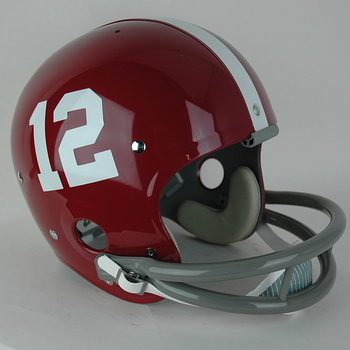 |
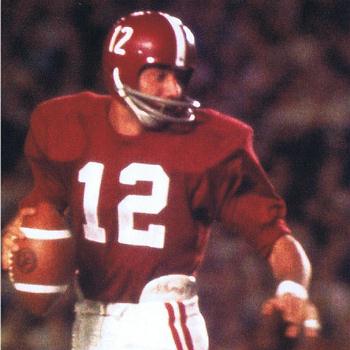 |
 |
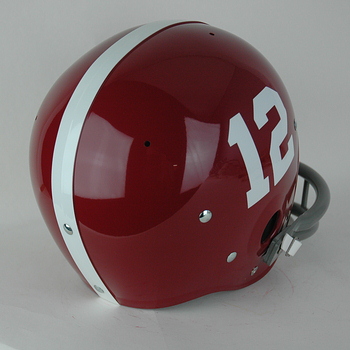 |
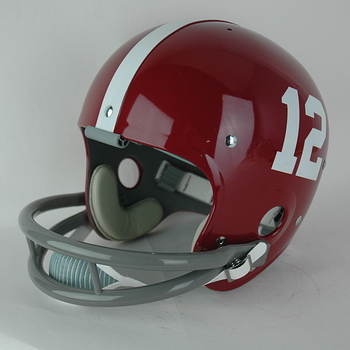 |
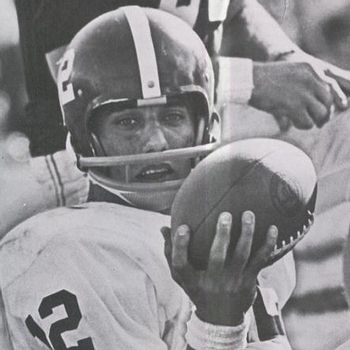 |
THE JOE NAMATH YEARS, 1962 – 1964:
Alabama football had truly arrived. Interestingly, with the great attention to detail and precision that Bama drills, practices, and game play became known for, the helmet numerals became a source of wonder for some. The three-inch thin rounded white numerals that were used on the 1961 cardinal helmets were replaced in ’62 by three-inch plain block style numbers. Bryant would carry the use of the block style numbers forward until the end of his coaching career but especially into the mid-1960s, the team would frequently enter the field of play with helmets adorned with different three-inch numeral fonts or thicknesses. On occasion in 1962 and ’63, some of the helmets would demonstrate a two digit number that utilized a rounded numeral in combination with a plain block style numeral. This was especially notable where a specific number would be damaged in play and then replaced by a “non-matching” numeral. There were games where Bryant continued to use the “alternate” white helmet shell on the entire team and games where only receivers and backs wore white.
It had not taken Coach Bear Bryant long to establish himself as one of the best in the nation nor move the Tide from the depths of the SEC to a National Championship. Bama's 1961 title seemed to be a natural progression of the plan Bryant installed upon his return to Tuscaloosa in 1958. As pint-sized tackle and future Clemson and Florida head coach Charlie Pell stated, the principal lesson he learned from his coach was to "think, then make a plan, then set about making it come true." Bryant had and the emphasis had been and remained on defense going into the 1962 season. However Bear was smart enough to realize that he had a quarterback who could throw as well as run and what is often lost among the many stories of Joe Namath's passing legacy is that he was an effective and excellent runner, a true athletic marvel prior to his knee injuries.
Namath came to Alabama from Beaver Falls, PA and the local legend immediately charmed the fan base and bulled his way into Pat Trammell's former spot as leader of the team and this was a team with great talent. Namath did his share as the sophomore lofted a fifty-two yard touchdown pass to end Richard Williamson, the future head coach of Memphis State and the Tampa Bay Bucs, on the fifth play of the '62 Georgia opener. His three scoring passes set the tone for the year as Bryant opened up the attack and relied upon his great Lee Roy Jordan-led defense which yielded but thirty-nine points in eleven games! The 7-6 loss to Georgia Tech on November 17 snapped the Tide’s twenty-six game winning streak but at 10-1, Second Team All Conference selection Namath had proven to Bryant that some offensive emphasis would win as he totaled 1192 passing yards and threw for thirteen touchdowns, huge numbers for the day. All SEC Second Team member Cotton Clark’s ninety points with ten touchdowns rushed from scrimmage set the pace for the conference. Of course, the defense was outstanding, ranking number two in the nation against the rush and scoring, and number three in total defense. All American Jordan was the dominant player but it was the swarming, gang-tackling mentality that altered college football’s perspective on the game. Halfback Butch Wilson enjoyed a seven year pro career as a tight end with the Colts and Giants and his son George was a guard for the Tide in the early-‘90s. Charlie Pell went on to a head coaching career at Jacksonville State, Clemson, and Florida and end Bill Battle won acclaim as Tennessee's head football coach from 1970-’76 before becoming the one individual who changed the face of licensing and marketing university athletic related products as the founder and president of Collegiate Licensing Corporation. He is currently the AD at Alabama. The Big Red Elephants closed the season strongly with a 38-0 shutout over Auburn and a 17-0 Orange Bowl victory over the Oklahoma Sooners.
SPOTLIGHT ON LEE ROY JORDAN:
Even by the standards of the early 1960s, Lee Roy Jordan was considered lean by some and skinny by others. However, he was a devastating force who roamed sideline to sideline as Alabama’s middle linebacker. Bryant famously stated of the 6’1”, 215 pound dynamo, “He was one of the finest football players the world has ever seen. If runners stayed between the sidelines he tackled them. He never had a bad day. He was one-hundred percent every day in practice and in games.” His play at center and on defense earned him two-time All Conference and All American selections while leading the squad to a 29-2-2 record during his time at Bama. He found the demands of Bear Bryant football much more pleasant than the life he grew up with on his parents’ Excel, Alabama farm. Hard work growing cotton, corn, and peanuts and raising the family’s cattle, hogs, and fowl gave Jordan an appreciation for long hours of back-breaking toil. He was recruited by happenstance by Tide assistant Jerry Claiborne who noted the ingrained aggressive nature of the two-way player. Jordan developed quickly and as a sophomore was a starter at both center and linebacker. A two-time All SEC and two-time All America choice, he was the epitome of Bryant’s small, quick, and incredibly hard-hitting defender. Jordan finished his first varsity season as the Bluebonnet Bowl MVP and in his senior season was the Orange Bowl MVP as the Tide defeated Oklahoma 17-0 and Jordan compiled an astounding thirty-one tackles. The first draft choice of the Dallas Cowboys in ’63, Jordan continued his all-over-the-field effectiveness, becoming the heart and soul of the famed Doomsday Defense, completing a fourteen year pro career with a team record 743 unassisted tackles and he added thirty-two interceptions and eighteen fumble recoveries to his defensive statistics. A two-time All Pro and five-time Pro Bowl selection, Jordan helped the Cowboys to three Super Bowl appearances and five NFC Championships. By the time he retired to a successful career in the lumber business, Jordan had been elected to the College Football Hall Of Fame as one of the greatest collegiate defenders of all time, and membership in the Cowboys’ Ring Of Honor. Playing for coaching legends Bryant and Tom Landry, Jordan was always respectful towards both but always emphasized the positive influence and effect in his life from Coach Bryant.
The 1963 defense was solid as always with sophomore Paul Crane taking over the two-way center and linebacker spot for the departed Lee Roy Jordan. Namath was famously suspended for the final game of the regular season against Miami and the Tide’s bowl game due to an off-the-field indiscretion but was still a Second Team All Conference selection. His absence allowed young Steve Sloan to step in at quarterback and he led the team to a 12-7 victory over Ole Miss in a snow-covered Sugar Bowl, elevating the Tide to 9-2 and a number eight ranking for the season. The close 10-6 loss to Florida on October 12 marked the final time in twenty years that a visiting team would leave campus with a win as the Tide then reeled off fifty-two consecutive victories in Tuscaloosa. Kicker Tim Davis was a weapon while the rushing duties fell to halfbacks Benny Nelson, another All SEC pick, and Steve Bowman. Moving fullback Jackie Sherrill to guard and having 6’5” Ray Ogden augment the rushing work gave the 1963 offense plenty of punch. Fullback Mike Fracchia, a rising star in 1961, lacked his previous effectiveness after the injury that kept him off the field in ’62. The depth of the team was obvious as big tackle Steve Wright, never a star, became a nine-year NFL veteran playing for five teams.
THE NATIONAL CHAMPIONSHIP SEASON OF 1964:
During the 1964 season a change was made in the identifying player numerals as the thicker plain block style three-inch numerals were replaced on most of the helmets by a thinner block font that had been utilized in ‘63. These same style numerals would remain in use until 1983 when a new decal supplier made a slight modification to the numerals, and that has remained the Alabama standard to the present day. Throughout the season however, the helmets continued to reflect a “mix” of three-inch font style numerals. Sufficiently chastised for his off- the-field mistake of ’63, Namath came storming back to take Alabama to the National Championship as an All American. With a knee injury suffered on October 10 against North Carolina State, Namath was limited in his ability to take the field at full speed and thus shared time with Steve Sloan who again excelled as he did as “the replacement” at the end of the ’63 season. Sloan impressed voters enough to be named to the All SEC team as a second team defensive back to ensure that he received some recognition for his fine quarterbacking behind Namath. "The Beaver Falls Bomber" however, remained the emotional leader of the squad. Paul Crane proved to be a worthy successor to Jordan at linebacker and center while full time center Gaylon McCullough was named All Conference. Receivers Tommy Tolleson, another All Conference selection and Ray Perkins gleefully caught passes from both quarterbacks. Halfback and kicker David Ray, defensive tackle Dan Kearley, a former Talladega High School great and teammate of Tolleson on their terrific 1960 team that saw eleven of a total of twenty-three players receive college football scholarships, and guard Wayne “Foots” Freeman were all named as All Americans. Steve Bowman was an All SEC rusher and tall halfback Ray Ogden became a good tight end, stopping at four NFL cities in his seven pro seasons. Mickey Andrews, a two-year letterman back and receiver, added baseball skill to his resume and earned the Hugo Friedman Award as the school’s best all-around athlete. He gained greater fame as Bobby Bowden’s long-time defensive coordinator at Florida State. The Orange Bowl ended in a 21-17 loss to Texas as Namath was stopped inches from the goal line on a fourth down attempt that many still insist was successful. Despite the loss, nothing could diminish the otherwise undefeated accomplishment of this team as the 1964 National Champion. The day after the game, Namath sat at the Harbour Inn hotel in Miami Beach and signed a contract worth $400,000.00 with the New York Jets and changed the face of professional football forever.
SPOTLIGHT ON JOE NAMATH:
Almost every football fan, young and old, knows the story of Joe Namath, reverentially called “Joe Willie” to this day in Alabama with a “southernization” of his name meant to endear him further to Alabama fans. The confident all around athlete was proficient enough to entertain offers from six Major League Baseball teams upon high school graduation but his mother and brothers encouraged him to attend college. He was ticketed for Maryland after a storied career at Western Pennsylvania’s Beaver Falls High School but falling a bit short on his standardized test score he instead visited Bama where legend has it that he was the only high school recruit that Bear Bryant invited to join him up in his famous coaching tower during practice. When the squad witnessed this, it was obvious that the recruit was special and he certainly proved that to be true. Namath took charge of a talented team and proved to be a great quarterback and greater leader. His charismatic style won his teammates over and the 29-4 record and National Championship compiled in his three collegiate seasons, despite a serious knee injury, has made him a college football legend. Namath’s ability equaled the publicity with All American status, numerous clutch performances, and as a member of Alabama’s Team of the Sixties and Team of the Century. Drafted in the first-round by both the NFL Cardinals and AFL Jets, Namath changed the salary structure of the game by signing for a then unheard of $400,000.00, and becoming the centerpiece for the Jets’ franchise after being named AFL Rookie Of The Year. His off-the-field lifestyle combined with his dynamic playing style led to his “Broadway Joe” persona, and he utilized his glorious bachelor/ladies’ man reputation to gain entry to the world of television commercials and roles in a number of movies. A member of the Pro Football Hall Of Fame and All Time AFL Team, Namath was the 1968 Pro Athlete Of The Year primarily due to his performance in Super Bowl III where he guaranteed victory over the highly favored Colts and delivered in a great example of unparalleled leadership. Though he was the first to throw for over 4000 yards in a fourteen game season, Namath’s statistics were not unduly impressive but it was his ability to have his teammates play to their limit combined with great clutch performances than won him acclaim and affection.
If interested in any of these Alabama helmets please click on the photos below.